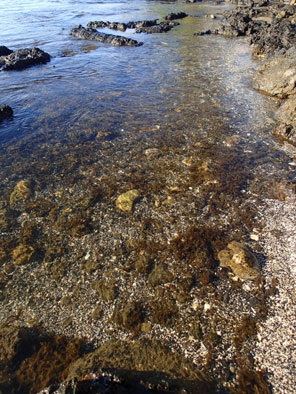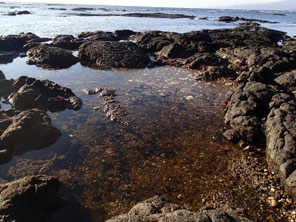Algal Bloom
As members of the Puako Community, Jupiter coordinated with the Department of Health, The Nature Conservancy, Eyes of the Reef and others to help identify an unusual algal bloom in the bay.
See Report:
Visual Assessment of Puako Algal Bloom (July 29th, 2012)
Linda Preskitt, Eyes of the Reef Coordinator
On Sunday, July 29th, 2012, a visual assessment was conducted of the Puako waterfront north from in front of the Holoholokai Beach Park (North of Mauna Lani) to the seawall in front of Puako #129. Measurements of water temperature were taken and notes on water clarity, presence or absence of algal growth and the overall state of area.
Observations: (please see map below for location of waypoints)
The area from south of Paniau to Puako #144 had great conditions with excellent water clarity and lower than expected biomass of algae. There were micro-turfs on rocks and in tide pools and small patches of limu 'aki'aki (Ahnfeltiopsis concinna), a common intertidal algae found on basalt ledges.
As one neared Puako #148 the water clarity was less with the water looking murky. Moving North, in front of Puako #144 (WP004, 005) slimy patches started appearing on surface of water in tide pools. In the shallow water in front of Puako #142 (WP006) the unusual algae appeared floating in water. It was not attached to the bottom. A noticeable fishy smell was present. Upon reaching the area adjacent to Puako #140 (WP007) the algae and smell became more apparent.
The bay running from Puako #140 north to Puako #130 was extremely fouled by decaying algae on the beach and large biomass floating in the water. The smell coming off of the water and from the decaying algae was horribly odorous. Chad Wiggins (TNC) reported finding dead, flat white worms (pic) of unknown origin in the algal mats in the water near shore. In this area, the algae are attached to the substrate and floating in the water column. The tide pools at the north end of this bay were also extremely fouled with a large amount of algal biomass in the water and scum and foam coating the surface. A spear fisherman leaving the water reported a large area at about 5-6 feet deep where the algae were thickly growing attached to the substrate (see map below). Just north of this bay, the conditions immediately started to improve. The water clarity was almost back to normal and there were no signs of algae in the water or on the beach.
Conclusions:
Water conditions in the bay in front of the Shoreline entrance at Puako 138-140 are fouled by an algal bloom of Biddulphia sp and Melosira sp, both common, non-toxic colonial diatoms. Diatoms are microscopic algae that have siliceous cell walls, thus taking advantage of silica in the environment. Diatoms require nutrient-rich conditions in which for growth so a heavy bloom such as this may be indicative of high nutrient input.
Though these algae are not harmful to humans, they can cause ecological damage by smothering the benthic community and competing with other algae, such as the turfs favored by turtles. Diatom blooms are known to dissipate quickly upon the removal of the nutrient input.
It appears the water is contaminated by an underground source of nutrients/pollution that may be coming to the surface in the middle of the bay, thus the reported growth on the reef flat. Possible sources are cesspools at the nearby houses on the shoreline or other nutrient inputs such as fertilizers. With the described conditions of the area, it is likely that there could be dangerous bacteria and microbes in the water and on the beach.
It is recommended that this area should be closed to any activity and that no one enter the water at this shoreline access until this situation is remediated. Thorough water quality tests should be performed, including bottom grab samples from reef flat. In addition, the source needs to be identified which might be accomplished by adding markers to the nearby cesspools and taking water samples from reef flat for detection.
Puako Map: GPS waypoints marked to show location of observations, samples, and pictures. Circled area is reef flat where large algae patch was observed by fisherman
| WP001-002, up to WP003 | Water temp varied between 81.3 and 83.2oF. Water clarity was very good. There was very little algal growth, mainly consisting of micro-turfs and localized areas of Limu aki aki (a common intertidal algae on basalt benches) |
| WP003 | Water temp 84.4oF. Water clarity is discernibly murkier. |
| WP004 | Water temp 84oF. Tidepools have slimy patches on surface of water. |
| WP005 | Water temp 83.7oF, Tidepools have unusual yellow sediment/deposit on substrate. |
| WP006 | Water temp 84oF. Brown algae floating in water and on surface. None is attached to substrate. |
| WP007 | Water temp 84.9oF. Concentration of algae in water column is more pronounced and noticeable bad smell. |
| WP008 | Beach in front of Puako 132-138. Extremely high concentration of algae in water with a very foul smell, possibly from decaying algae washed up on beach. Algal biomass increases as you move North. |
| WP010 | Water temp 84.7oF. Tidepools in front of Puako #130 and 132 are very fouled with a high biomass of algae and heavy foam/scum on water surface. This appears to be the northern point of algal bloom. Pictures taken of beach both South and North show the immediate difference between the two areas. |
| WP011 | Water temp 83.7oF. Water clarity and beach conditions back to normal with no algae in water or on beach. |
WP0011: Photo facing south towards beach with algae debris and north from same spot showing unaffected beach
WP004: Tidepools with slimy patches and foam on surface of water
WP005: Tidepools have unusual yellow sediment/deposit on substrate
WP006: Brown algae floating in water and on surface, not attached to substrate
WP008: Beach in front of Puako 132-138, extremely high concentration of algae in water with a very foul smell, possibly from decaying algae washed up on beach
WP010: Tidepools in front of Puako #130 and 132 (northern point of algal bloom) are very fouled with a high biomass of algae and heavy foam/scum on water surface
Unidentified white worms in algae (photo by Beth Goodwin)
For more about these projects, please contact us at whale-studies-info@jupiterfoundation.org










